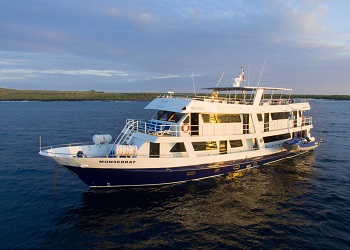Archipell Itinerary B4 - 4 Days
ITINERARY B4 - 4 DAYS
MONDAY
AM: Baltra: Arrival and Transfer to the boat
PM: Bachas Beach (HK/SN)
TUESDAY
AM: Genovesa: Prince Phillip's steps (HK/KY/PR/SN)
PM: Genovesa: Darwin Bay (HK/KY/PR/SN)
WEDNESDAY
AM: Bartolome (HK/SN/PR)
PM: Santiago: Sullivan Bay (HK/SN)
THURSDAY
AM: Santa Cruz: El Chato Reserve / Twin Craters (HK)
Baltra: Transfer to the Airport
HK: HIKE / SN: SNORKEL / PR: PANGA RIDE / KY: KAYAK /
PB: PADDLE BOARD
DAY 1: MONDAY
AM: BALTRA ARRIVAL AND TRANSFER TO THE BOAT
A guide will meet you, help you collect your luggage, and escort you on a short bus ride to the harbour.
PM: SANTA CRUZ: BACHAS BEACH.
Around noon you will embark from Baltra airport on the Archipel cruise. Your cabins will be assigned, and lunch will be promptly served. Your first excursion will take place this afternoon after 14:00 PM, at Bachas beach. This is a lovely bay with soft, white coral sand that is frequently visited by sea turtles to lay their eggs, so please,watch your step! After enjoying some leisure time at the beach, you could explore a small lagoon hidden behind some bushes, where occasionally it is possible to observe flamingos, black-necked stilts, and whimbrels. You might also observe some rusty barges, which were abandoned here after WWII when the USA rented this island as a strategic point to protect the Panama Channel from Japan. After two hours on this visit, you will return onboard.
DAY 2: TUESDAY
AM: GENOVESA: PRINCE PHILIP'S STEPS.
Before landing, you will take a dinghy ride along the eastern arm of the caldera. As you approach, the soaring 25 m/80 ft high walls become overwhelming. Sometimes, a Galapagos fur seal is resting or a seabird is nesting on one of the ledges at the base. You will then have to hike and overcome the steep stairs from the landing dock to a bush of palo santo shrubs on top. Red-footed boobies gratefully use these scarce nesting places; so that they don’t have to nest on the rocky ground. Upon arriving at the edge of the rim, the bushes open up and you can enjoy panoramic views, a strong sea breeze and the amazing flying skills of countless seabirds. Following the exposed rim, you will first pass the Nazca boobies and finally reach the extensive storm petrel nesting places, where, if you’re lucky, you can spot the well-camouflaged short-eared owl hunting for food!
PM: GENOVESA: DARWIN BAY.
Inside the submerged caldera of Genovesa lies Darwin Bay, with a diameter of more than 1.5 km/1 mi and it is almost 200 m/650 ft deep. The small area will surprise you repeatedly, walking along a coral sand beach, crossing barren lava formations and creeks, passing tidal pools, shrubs and further ahead following the top of some cliffs. With these peaceful surroundings, every single species has occupied its own ecological niche (or habitat) without disturbing others.
DAY 3: WEDNESDAY
AM: BARTOLOME.
The beautiful volcanic islet of Bartholome is among the youngest of the islands and, on a geological scale, was just recently born out of the fire. Although it looks lifeless at first sight, Bartholomew offers some of the wildest landscapes and best panoramas of the entire archipelago. To enjoy the postcard view of the idyllic “Pinnacle Bay” you will have to climb the stairs to the viewpoint on top of the island (114 m/375 ft). Enter a dramatic world of threatening (though extinguished) nearby spatter cones, craters, and lightweight lava droplets that have been spewed out by fiery fountains. The summit trail is also ideal for witnessing how scanty
pioneer vegetation, such as lava cactus, struggles to take root in the bare virgin lava fields.
PM: SANTIAGO: SULLIVAN BAY.
The arrival in Sullivan Bay is like a moon landing. The desolate, sprawling fields seem to be mostly lifeless, but this island, which is particularly popular among photographers, still offers a lot to see. There is even some life! Green sea turtles burrow in the small white sand beach, where you can also find crabs, blue herons and oystercatchers.
DAY 4: THURSDAY
AM: SANTA CRUZ: TWIN CRATERS AND EL CHATO RESERVE.
The native scalesia forest of El Chato Tortoise Reserve is the best place to search for Galapagos giant tortoises in their most authentic setting! Despite the interesting breeding centres – where you are guaranteed to find tortoises in their corrals – there is nothing better than to observe them in their wild environment. Though it can be quite moist and muddy, your visit may turn into an adventurous quest when they have left their favourite pond silently. The Twin Craters are found on either side of the road leading to Puerto Ayora. These impressive formations are not really volcanic craters and were formed by magma domes, which hardened on the outside while the lava continued flowing inside, leaving huge and empty magma chambers that eventually collapsed, leaving two large holes. The craters lie within a lush scalesia cloud forest, a high-altitude plant species that are endemic to the Galapagos. This area is also home to the carpenter finch, which uses tools to search for food. There may also be opportunities to see the vermillion flycatcher, a small red-breasted bird.
After this, assisted by the naturalist guide and some crew members, you will be taken to Baltra airport. It has been a pleasure accompanying you on this unique trip and we hope to see you again very soon!







